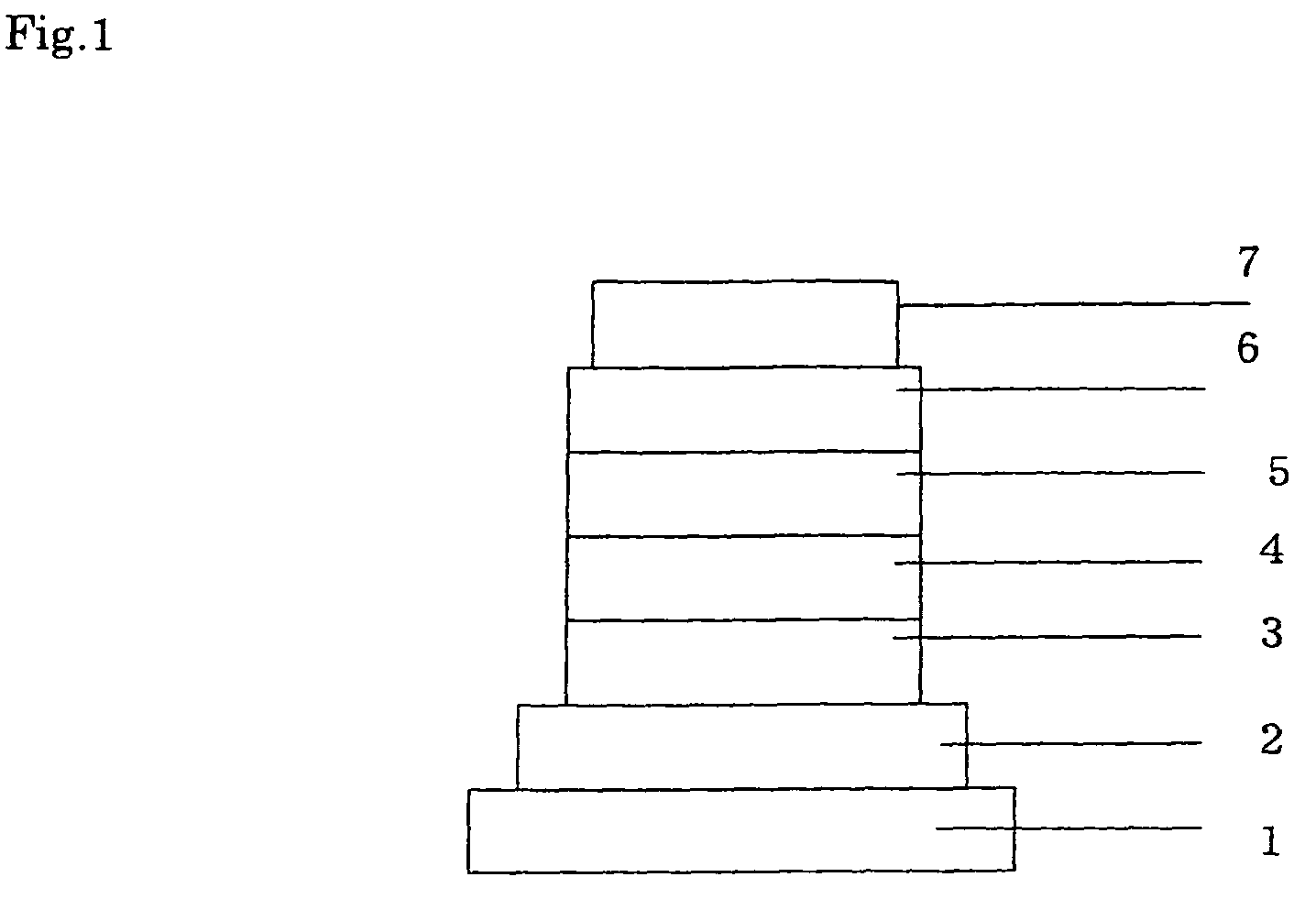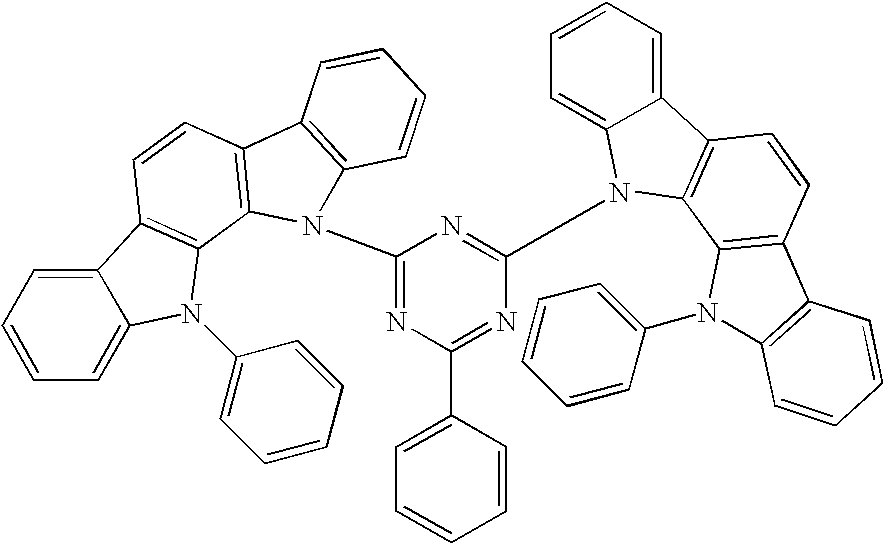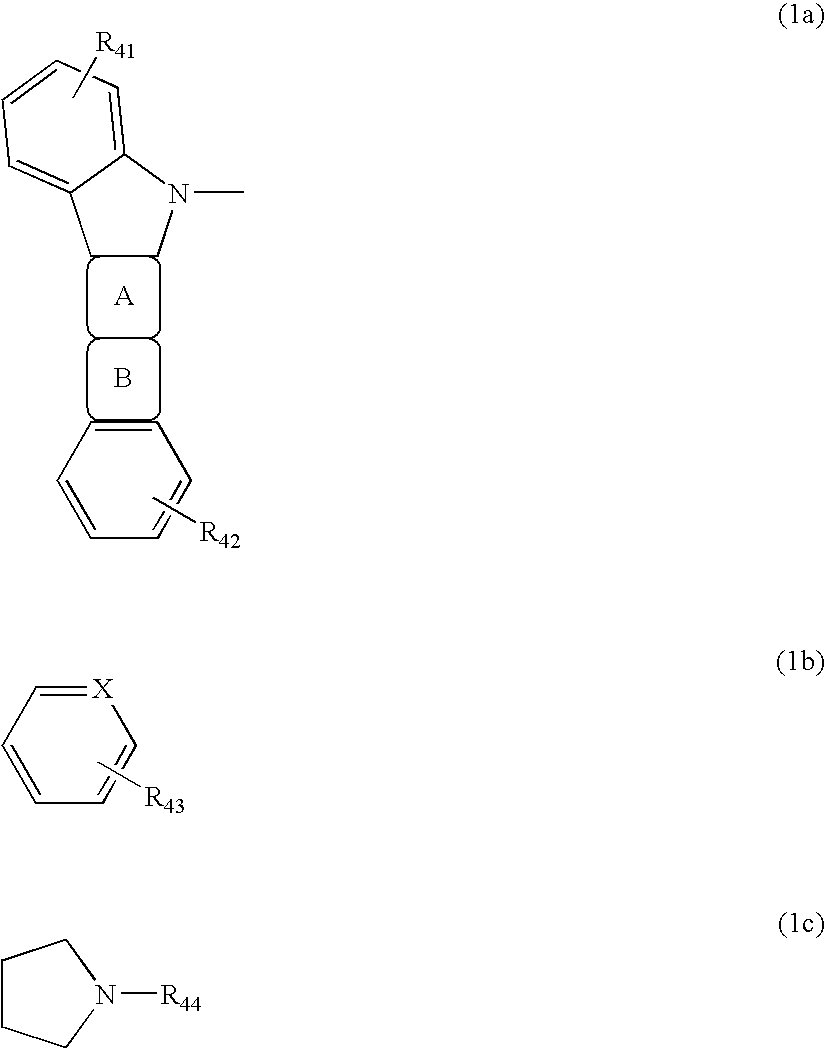Compound for use in organic electroluminescent device and organic electroluminescent device
a technology of electroluminescent devices and compounds, which is applied in the direction of discharge tube luminescnet screens, anthracene dyes, applications, etc., can solve the problems of failure to emit light at high efficiency, bcp lacks reliability as hole blocker material, and the device comprising bcp shows an extremely short operating life, so as to improve the luminous efficiency of the device, secure the driving stability of the device, and high efficiency
- Summary
- Abstract
- Description
- Claims
- Application Information
AI Technical Summary
Benefits of technology
Problems solved by technology
Method used
Image
Examples
example 1
Synthesis Of Compound 9
[0068]In a 200-ml three-necked flask that had been deaerated and filled with nitrogen were placed 5.0 g (44.59 mmol) of 1,2-cyclohexanedione and 12.9 g (89.21 mmol) of phenylhydrazine hydrochloride, then 145 ml of ethanol was added, and the mixture was stirred. To the contents of the flask was added 0.45 g (4.59 mmol) of concentrated sulfuric acid in drops over 5 minutes. The mixture was then heated to 65° C. and stirred at this temperature for 4 hours. The mixture was cooled to room temperature, the violet brown crystals formed were collected by filtration, reslurried twice with 50 ml of ethanol, and dried under reduced pressure to give 12.0 g (43.59 mmol, 97.7% yield) of a violet brown powder.
[0069]Then, 12.0 g (43.59 mmol) of the violet brown powder obtained above was placed in a 300-ml three-necked flask, 140 g of acetic acid and 8.0 g of trifluoroacetic acid were added, and the mixture was stirred. The mixture was then heated to 100° C. and stirred at thi...
example 2
Synthesis of Compound 40
[0072]In a 2000-ml three-necked flask that had been deaerated and filled with nitrogen were placed 33.3 g (297.0 mmol) of 1,2-cyclohexanedione and 86.0 g (594.7 mmol) of phenylhydrazine hydrochloride, then 1000 ml of ethanol was added, and the mixture was stirred. To the contents of the flask was added 3.0 g (30.6 mmol) of concentrated sulfuric acid in drops over 5 minutes. The mixture was then heated to 65° C. and stirred at this temperature for 4 hours. The mixture was cooled to room temperature, the violet brown crystals formed were collected by filtration, reslurried twice with 500 ml of ethanol, and dried under reduced pressure to give 80.0 g (280.5 mmol, 96.3% yield) of a violet brown powder.
[0073]Then, 72.0 g (261.5 mmol) of the violet brown powder obtained above was placed in a 1000-ml three-necked flask, 720 g of acetic acid and 72.0 g of trifluoroacetic acid were added, and the mixture was stirred. The mixture was then heated to 100° C. and stirred ...
example 3
Synthesis of Compound 27
[0078]In a 2000-ml three-necked flask that had been deaerated and filled with nitrogen were placed 33.3 g (297.0 mmol) of 1,2-cyclohexanedione and 86.0 g (594.7 mmol) of phenylhydrazine hydrochloride, then 1000 ml of ethanol was added, and the mixture was stirred. To the contents of the flask was added 3.0 g (30.6 mmol) of concentrated sulfuric acid in drops over 5 minutes. The mixture was then heated to 65° C. and stirred at this temperature for 4 hours. The mixture was cooled to room temperature, the violet brown crystals formed were collected by filtration, reslurried twice with 500 ml of ethanol, and dried under reduced pressure to give 80.0 g (280.5 mmol, 96.3% yield) of a violet brown powder.
[0079]Then, 72.0 g (261.5 mmol) of the violet brown powder obtained above was placed in a 1000-ml three-necked flask, 720 g of acetic acid and 72.0 g of trifluoroacetic acid were added, and the mixture was stirred. The mixture was then heated to 100° C. and stirred ...
PUM
| Property | Measurement | Unit |
|---|---|---|
| Tg | aaaaa | aaaaa |
| temperature | aaaaa | aaaaa |
| temperature | aaaaa | aaaaa |
Abstract
Description
Claims
Application Information
 Login to View More
Login to View More - R&D
- Intellectual Property
- Life Sciences
- Materials
- Tech Scout
- Unparalleled Data Quality
- Higher Quality Content
- 60% Fewer Hallucinations
Browse by: Latest US Patents, China's latest patents, Technical Efficacy Thesaurus, Application Domain, Technology Topic, Popular Technical Reports.
© 2025 PatSnap. All rights reserved.Legal|Privacy policy|Modern Slavery Act Transparency Statement|Sitemap|About US| Contact US: help@patsnap.com



